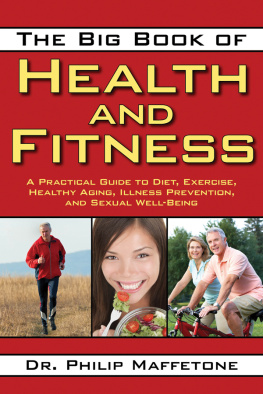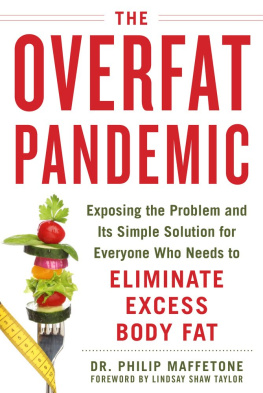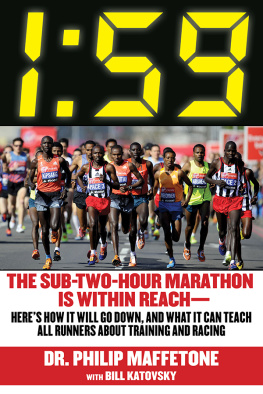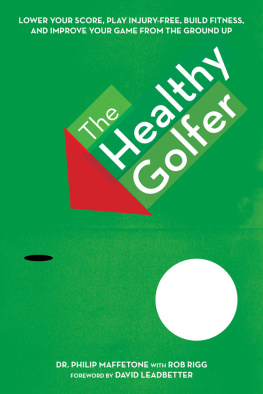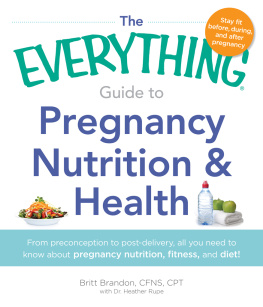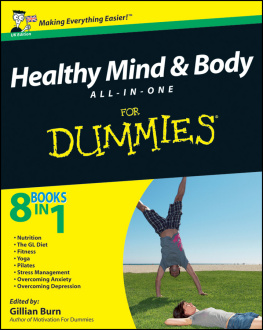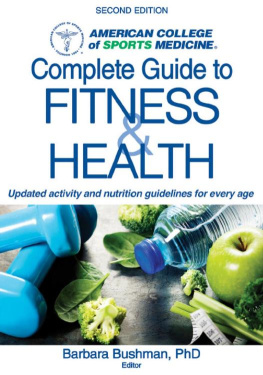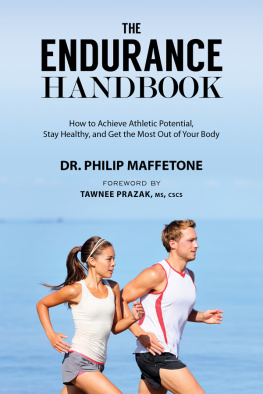Copyright 2012 by Philip Maffetone
All Rights Reserved. No part of this book may be reproduced in any manner without the express written consent of the publisher, except in the case of brief excerpts in critical reviews or articles. All inquiries should be addressed to Skyhorse Publishing, 307 West 36th Street, 11th Floor, New York, NY 10018.
Skyhorse Publishing books may be purchased in bulk at special discounts for sales promotion, corporate gifts, fund-raising, or educational purposes. Special editions can also be created to specifications. For details, contact the Special Sales Department, Skyhorse Publishing, 307 West 36th Street, 11th Floor, New York, NY 10018 or .
Skyhorse and Skyhorse Publishing are registered trademarks of Skyhorse Publishing, Inc., a Delaware corporation.
www.skyhorsepublishing.com
10 9 8 7 6 5 4 3 2 1
Library of Congress Cataloging-in-Publication Data
Maffetone, Philip.
The big book of health and fitness : a practical guide to diet, exercise, sexual well-being, healthy aging, and illness prevention / Philip Maffetone.
p. cm.
ISBN 978-1-61608-379-3 (pbk. : alk. paper)
1. Health. 2. Physical fitness. 3. Nutrition. 4. Self-care, Health. I. Title.
RA775.M34 2012
613.7--dc23
2011035885
Printed in the United States of America

CONTENTS

INTRODUCTION
H ealth care has turned into health scare. Those with health insurance worry about rising premiums or limited and dropped coverage. Those without insurance keep their fingers crossed that they wont get chronically sick or injured. Guided more by rising costs and administrative duties, doctors are forced to become less personal and more bureaucratic. Emergency rooms have turned into crowded, makeshift physician offices for the uninsured.
How did the health care crisis become so acute in America? And what can you do as an individual not to become a victim of our deeply flawed medical system? After all, one of the main reasons families go into debt, even bankruptcy, is due to hospitalization or long-term care.
What if there is a sensible, cost-effective way to remain healthy, even into old age? And what if this only requires that you learn how to take responsibility for your own health? Because the best alternative to health scare is selfhealth care .
Its why I wrote this book.
When I first began my private practice in holistic, complementary medicine in Upstate New York in 1977, the health care landscape was much different than it is today. Patients would come to my clinic with all sorts of common aliments, including fatigue, back pain, asthma and allergies, and intestinal complaints. Most of these problems I treated right there in my office, or in some cases, I would refer a patient to a specialist for further diagnosis, especially with heart or neurological disorders. I would also give each patient a list of specific lifestyle recommendations that matched his or her needs regarding diet, stress, and regular exercise. I believed that the body most often best heals itself once proper nutrients and physical activity are balanced and stress is regulated. Medication or surgery should only be used as the last resort. And I did mean last.
Once a patient left my office after getting treated and paying me, it was up to that individual to collect from his or her insurance company. Paperwork and bookkeeping were kept at a minimum, especially for me. But as the years went by, the insurance companies, along with a heavy hand from government and lobbyists, began to dictate which therapies would be allowed and even which type of doctors could apply them. Regulations and restrictions increased. Red tape ensnared the system. Costs skyrocketed. Hospital administrators and health insurance company bureaucratsnot doctorsnow determined the quality of medical care. Insurance premiums began to soar. As expected, the ranks of the uninsured rapidly began to increase. Ultimately, the health care landscape became so dysfunctional that it contributed significantly to the reason why I decided to leave a successful private practice after twenty years (I continued to privately consult on a limited basis).
While most of the everyday health problems that I used to address with my patients have remained the same, theres one thing thats noticeably different: people no longer fully participate in the process or understanding when it comes to their own health care. Most have forfeited control over their own care to an indifferent Big Brother health care system overseen by MBA grads with their spreadsheets and financial forecasts and not by trained medical professionals.
The centuries-old Hippocratic Oath, handed down by the Greeks, and which required physicians to swear that I will prescribe regimens for the good of my patients according to my ability and my judgment and never do harm to anyone, has been replaced by the Hypocrisy Oath, which demands that no financial harm should be done that will affect the bottom line of HMOs.
Ironically, people are living longer. Thats due to technological advances and better hospital care, not because everyone is truly healthier. While millions are blowing out more candles on their sugar-fortified birthday cakes, their latter years can hardly qualify as healthy, active, and quality living. The average American spends his or her last twelve years in a state of physical and mental dysfunctionoften unable to care for himself or herself and draining untold amounts of money for critical life support. As a result of poor diet and lifestyle decisions, many old age diseases such as cancer and heart disease have migrated toward middle age, and even all the way to our overfat youth where diabetes has become a growing problem.
Todays health care is a huge fiction wrapped inside a much bigger lie. The health industrial complex is a sprawling juggernaut in which providers are for-profit businesses, consumers have been stripped of their freedom, and health care professionals are caught smack in the middle. Despite the fact that most chronic diseases can be prevented, theyre not. The reason is that causes of disease are not adequately addressed, and instead, only the symptoms are usually treated. Its a disease-care system thats broken way beyond repair. Now all we can do is wait for the worst to happenand hope that someday we dont get sick.
But wait for what? Companies sell their unhealthy products to the public with the full knowledge that they will someday lead to chronic sickness and disease. The cycle of ill health is perpetuated. For example, cigarettesexposed decades ago as a deadly habitare still being sold despite the surgeon general warning labels and higher taxes. Banning or taxing soft drinks is the current target of health advocates, but the beverage giants such as Coke and Pepsi simply respond by spending more money on advertising and marketing, even going so far as supporting public school projects. Or take the case of unregulated over-the-counter drugs that claim to treat everything from joint pain to insomniabut also come with a long list of unpleasant side effects. All these products are marketed to consumers in every conceivable wayradio, TV, Internet, magazines, newspapers, billboardsbrainwashing almost everyone into eagerly accepting unhealthy food, drink, and pills as the American way.
Its the ideal, profitable business modelsell harmful products to people that will eventually make them sick and then sell them goods and services to keep them alive for many more years but then ultimately claim success because everyone is living longer. Start them early with Juicy Juice and Frosted Flakes as toddlers, fill their bellies with fast food and highly processed packaged fare as teens and adults, and when they are infirmed geriatrics, load them up with Maalox and meds. Its a cradle-to-grave rip-off. And its no surprise that the top five preventable conditions in the United States are heart disease, cancer, stroke, lung conditions, and diabetes.

